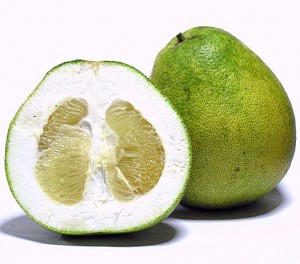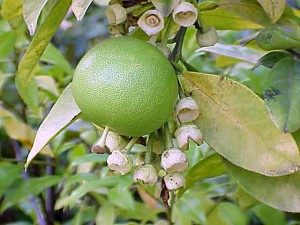 Pomelo (Citrus maxima or Citrus grandis) or Pummelo is a largest citrus fruit native to Malaysia and South East Asia. Pomelo is, essentially, a kindler, gentler, giant cousin of the grapefruit. It is similar in flavor but milder, and is actually believed to be a forebear of the modern grapefruit.
Pomelo (Citrus maxima or Citrus grandis) or Pummelo is a largest citrus fruit native to Malaysia and South East Asia. Pomelo is, essentially, a kindler, gentler, giant cousin of the grapefruit. It is similar in flavor but milder, and is actually believed to be a forebear of the modern grapefruit.
The fruit of the pomelo is round to slightly pear shaped. It may grow to a diameter of 12 inches or more and attain a weight of 9 to 10 kg. The easy-to-peel greenish yellow rind is thick and contains a dense layer of spongy pith. The flesh, divided into about sixteen to eighteen segments, varies from a pale straw color to pink to deep rose. Some pomelos contain an excess of seeds and others are nearly seedless.
The pomelo tastes like a sweet, mild grapefruit, though the typical pomelo is much larger in size than the grapefruit. It is generally quite sweet and it can be enjoyed in any way the grapefruit can. If the segments are eaten raw, out of hand, the membrane is usually removed from them prior to eating, as it can be quite tough. The peel is sometimes used to make marmalade, or candied, then (sometimes) dipped in chocolate. The peel of the pomelo is also used in Chinese cooking. In general, citrus peel is often used in southern Chinese cuisine for flavoring, especially in sweet soup desserts.
Pomelos are an excellent source of antioxidant flavonoids, a good source of potassium, and each serving will provide about twice the daily recommended amount of vitamin C.
In the Philippines, the fruit is popularly known as the suha, or lukban, and is eaten as a dessert or snack. The pomelo, cut into wedges, is dipped in salt before it is eaten. Pomelo juices and pomelo-flavored juice drink mixes are also common.
Pomelos are extensively grown in the Philippines because they are widely adapted to local soil and climatic conditions. Some of the pomelo varieties grown in the country are the Amoy Mantan, Magallanes, Panacan, Mintal, Aroman, Sunwui Luk, and Siamese Selections.
How to grow Pomelo or Suha
SOIL REQUIREMENT
- Adapted to a wide range of soil types provided they are reasonably deep, and well-drained.
- Optimum pH range from 5.5 – 6.5
- When pH is below 5, liming is required.
CLIMATIC REQUIREMENT
- Grow in lowland tropics with elevation up to 400 meters above sea level with optimum temperature of 23-30 degrees Celsius.
- Annual rainfall requirement is 1500-1800 mm.
LAND PREPARATION
- Clear/remove all stumps, woods and colony of termites
- Plow and harrow to loosen the soil
- If the soil is acidic, incorporate dolomitic lime during plowing or harrowing
- Lay outing and distancing of plants.
- Pomelo are planted from 6 meters to 12 meters apart depending on the terrain and fertility of the soil.
PREPARATION OF HOLES AND PLANTING
- Dig a cubical hole measuring 50 cm wide and 50 cm deep. The hole will be filled up with a mixture of 50% decomposed manure, and 50% top soil.
- Remove the plastic bag and plant the seedling into the prepared hole without breaking the ball of soil. Prune the roots to enhance root branching.
- Plant the seedling when the leaves are mature.
- Cover the hole with soil and press gently the surface.
- Planting should be done at the onset of the rainy season.
CARE AND MANAGEMENT OF NEWLY PLANTED SEEDLINGS
- Water the plants immediately after planting to assure close contact between soil and roots and prevent wilting.
- Apply fertilizer three(3) months after planting (50-100 grams 16-20-0)
- Control the weeds manually, by mulching or using herbicides.
- Prune water sprouts or shoots that emerged below the graft-bud union.
- Spraying of foliar fertilizer that contains Iron, Zinc and Magnesium to prevent deficiency.
CARE AND MANAGEMENT OF NON-BEARING AND BEARING TREES
- Weeding( manual or chemical)
- Mulching (plant debris)
- Manuring( chicken dung)
- Irrigation (done during flushing, flowering, fruit setting and fruit enlargement)
- A matured pomelo tree requires 100-200 liters of water per day during dry period.
- Pruning – done by hedging or topping to control height, improve light penetration and air circulation. First pruning is done 4-6 months after planting to induce branching.
- Girdling or Cincturing – to increase fruit setting and fruit retention done during blooming.
- Fertilizer application (Based on Soil and Leaf Tissue Analysis)
- Top Working or Crown grafting – method of renewing/rehabilitating matured or undesirable trees.
TIMING OF FERTILIZER APPLICATION
- Apply fertilizer when there is a sign of flushing and the soil is moist.
- Fertilizer should be applied in 2-3 installments; during the onset of rainy period, middle and towards the end of the rainy season.
- Fertilizers are applied by digging holes at 20-30 cm deep around the tree at the distance of 100-200 cm from the trunk. Cover the fertilizer with top soil to prevent evaporation and erosion.
- Source of fertilizer-Organic and Inorganic (liquid/granule) fertilizer.
- Foliar fertilizers are applied on the following stages: 40, 60, 80, 100,120,140 days after fruit setting.

HARVESTING
Pomelos are matured with the following indicators:
- 140-160 days from fruit set
- Change in color; from green to light green and light green to yellow
- Total soluble solids(8-9 %)
- Hollow sound when tapped
- Easy to harvest-easily detach from the fruit stalk
METHODS AND TECHNIQUES IN HARVESTING
- Fruit is harvested by clipping the stalk with pruning shears during sunny day. It is best to have 10-15 cm of stalk left in the fruits for better presentation.
- Do not harvest when fruits are wet.
- Spot- picking of fruits- selective harvesting
- Clean-picking of fruits- all matured fruits are harvested.
POST HARVEST HANDLING
The life span of harvested pomelo defends on the following factors:
- Delay in harvesting
- Packing and cooling
- De-greening conditions
- Fungicidal treatment
- Waxing
- Seal Packaging
- Temperature and RH management
- Presence of ethylene in storage
PESTS AND DISEASES
Among the leading insect pests of pomelo in the Orient are a leaf miner, Phyllocnistis citrella; a flea beetle which attacks the leaves; a stinging red ant (Pheidologeton sp.) that damages roots, twigs, leaves and trunk, sometimes girdling and killing the tree. Scale insects (Chrysomphalus aonidum and C. aurantii, Coccus hesperidum, Lepidosaphes gloverii, Parlatoria brasiliensis and P. zizyphus, Pseudaonidia trilobitiformis, and Saissetia sp.) are prevalent but are partly controlled by natural enemies –a black ant (Dolochonderus sp.) and a parasitic fungus, Aschersonia aleyrodis. The weaver ant, Oecophylla smaragdina, tends scale insects for their honeydew. Fruit growers in China and Southeast Asia put out chicken entrails to encourage the weaver ant to construct its long, hanging nests on citrus trees because it controls the tree borers (Pentatomidae) and other pests. Though beneficial, it is a nuisance at harvest time because it inflicts painful stings. The “eggs” (pupae) are commonly eaten.
MEDICINAL USES:
In the Philippines and Southeast Asia, decoctions of the leaves, flowers, and rind are given for their sedative effect in cases of epilepsy, chorea and convulsive coughing. The hot leaf decoction is applied on swellings and ulcers. The fruit juice is taken as a febrifuge. The seeds are employed against coughs, dyspepsia and lumbago. Gum that exudes from declining trees is collected and taken as a cough remedy in Brazil.
Sources: Wikipedia.org and hvcc.da.gov.ph; Photos: Wikipedia.org